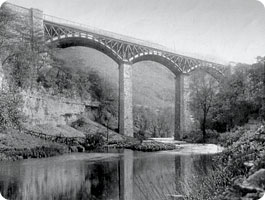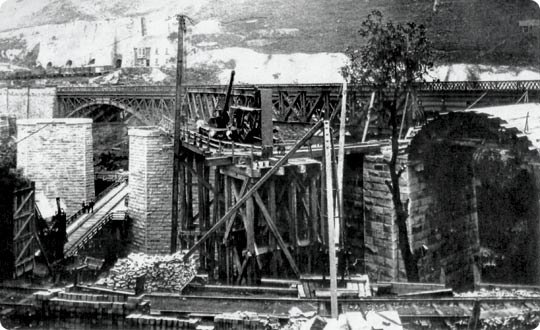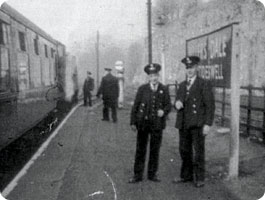The story of Millers Dale Station: The Right Hand Man
The story of Millers Dale Station: The Right Hand Man
To some, he was the saviour of the railways; to others, he was their butcher. Whatever your standpoint, it’s beyond debate that Richard Beeching’s report on ‘The Reshaping of Britain’s Railways’ did exactly what it said on the cover. There were no small measures. Over six years, 200,000 railwaymen joined the dole queue; the doors were locked on 2,300 stations; 4,000 miles of trackbed were plundered for scrap. A once-weighty public service took on a leaner form.
Though vigorous campaigns were often mounted, the fight to reprieve deserted platforms was futile. Emotional attachment could never conquer British Railways’ skewed economics. Felled branch lines littered the countryside. To successfully challenge a closure proposal, objectors had to establish that community hardship would result. Usually this uphill struggle proved insurmountable but, at the western edge of the Peak District, one famous victory was recorded over officialdom.

A stronghold of Manchester commuters, Buxton and its road network regularly surrendered to the vagaries of old-fashioned winters. So, in 1963, when BR announced its intention to sever both routes into the town, a deluge of acrimonious protestation rained down on the Transport Users Consultative Committee, which acted as arbiter on such issues. With a well-marshalled opposition, the plan’s fragile foundations were soon exposed, prompting arguably the most significant climb down of the Beeching era.
Of course, one battle does not win a war. Falling passenger revenues could not support the local network. When the axe was raised again three years later, the Midland Railway’s Buxton branch bowed to the inevitable. But of greater significance was the loss of its feeder route – part of the St Pancras-Manchester main line – which cut a spectacular course across the Peaks.
It was in 1845 that the Manchester, Buxton, Matlock and Midlands Junction Railway (there were no small measures when it came to company names either) placed plans before Parliament for a link into Lancashire from a junction on the North Midland Railway at Ambergate.
Engineer George Stephenson deemed that, through the hills, the new line would follow the Wye valley via Bakewell. His scheme did not pass muster with landowner the Duke of Rutland whose disapproval prompted a hasty return to the drawing board. An alternative plan was fashioned, taking the tracks north from Rowsley through the estate of the receptive Duke of Devonshire. Faced with a future bypassed by the railway, Bakewell’s anxious townsfolk appealed to the Duke of Rutland for a change of heart. He relented, but too late – Royal Assent was granted in August 1848.
As it transpired, these aristocratic manoeuvres were nothing more than a sideshow. The main event was now being played out in banks and boardrooms – the railway bubble had burst. A modest line was laid from Ambergate to Rowsley, welcoming customers in June 1849, but the route into Lancashire remained untouched for more than a decade.

Financial considerations aside, the ambitious Midland Railway longingly eyed the land of plenty which lay across the hills – domain of the London & North Western. These two rivals became embroiled in a tactical chess-like battle, each attempting to block any territorial expansion by the other. The LNWR enjoyed the upper hand, initially thwarting the Midland’s efforts to secure a main line through to Manchester.
Instead the pair descended on Buxton – the former constructing a line south from Whaley Bridge whilst, in May 1860, the Midland received the go-ahead for a 15-mile extension of the Rowsley line, entering the town from the east. This would serve Bakewell and entailed the excavation of seven tunnels, totalling 2,133 yards. Trains first rolled in May 1863, two weeks ahead of the competition.
The balance of power was shifting. Much to the LNWR’s fury, in 1862 the Midland had joined forces with the Manchester, Sheffield and Lincolnshire Railway to construct its missing link into Lancashire. Although geological troubles at Dove Holes Tunnel slowed progress to a crawl, the four-year slog eventually paid off and the signals were cleared in October 1866. Within weeks, an immense landslide consumed half-a-mile of track, restyling a viaduct. It was not until February 1867 that remedial work was finished and the Midland’s first London express hurtled towards Manchester.
Nestling in the valley two miles south of Tideswell was Millers Dale, a village of no great importance until the railway arrived. Bestowed upon it was the honour of hosting the junction station for Buxton and the main line. The junction itself was a mile-and-a-half to the west, through three tunnels.
The interchange was a sprawling affair, built on a man-made ledge and boasting a main building with two platforms, signal box, goods facilities and sidings. It was approached from the south over a high, elegant viaduct comprising three iron arches.


Traffic levels soared – expresses, stoppers, coal, goods. More sidings materialised. A bay was built for Buxton trains. Refreshments satisfied the appetite. And yet none of this treated the crippling congestion which grew from a mix of conflicting passenger, freight and local quarry services. Something had to give.
And it did. In 1903 powers were granted for the formation of a double track loop, allowing slow and fast trains to run separately through the station. The project devoured £90,000 – £6.6million in today’s terms. A second viaduct rose from the river; the main building was demolished and moved north; the goods yard sprawled. On the 1st April 1906, a new Millers Dale opened for business.

Around 40 trains per day paused to collect and set down. Although the station itself generated relatively little income, this was a vibrant place where passengers traded main line speed for the branch’s more sedate progress. The goods yard bustled with merchants for coal, milk and livestock.
Tideswell’s travelling public was ferried to the station by coach from the George Hotel. They were carried up and down to Buxton on a push-and-pull service, introduced in the mid-30s. Its serene approach went undetected by one platelayer who paid the ultimate price for his error.
Wartime arrivals at the branch terminus were greeted by Wilf Oven whose first turn of duty at Buxton, as a porter/guard, drew to a close in 1943. Postings to Burton-upon-Trent and Derby followed, before Buxton beckoned once again. “The spirit there was very good” he remembers. “You could do anyone’s job and anyone could do yours.”


In 1957, Wilf was installed as foreman at Millers Dale – the Station Master’s right hand man. His day followed a familiar routine. At seven o’clock, he’d unlock the station, light the fires and see to the Manchester engine which had to be run around for the journey into Buxton. Meantime the Station Master, who acted as sub-postmaster, would deal with the mail before heading off for breakfast. Millers Dale was the last station to have a Post Office on the platform.
Water for the toilets was pumped up from the river. The inlet had to be cleared daily. Drinking water came from the spring at a nearby farm. Wilf enjoyed the luxury of his own office but the only phone sat with the booking clerks.
Home was in Tideswell, as it had been throughout his adventures further afield. The railway families formed a close-knit community. Parties and outings were arranged, including one to the Festival of Britain. But there was little free time for the foreman – just one Sunday per fortnight. Late shifts finished when the last train had gone.
Team spirit was “a bit lacking. If I said ‘go and do something’, some would go and do it, others would say ‘do it your bloody self’!” When the lamp went out in the signal on platform 3, Wilf instructed a porter to go and sort it out. He refused, stating that a lampman was still on duty. This was true, but he lived in Tideswell so Wilf did the job himself. Some weeks later, the lamp was out again. “When I asked this chap to sort it out he told me that he couldn’t climb ladders, so I had to do it myself again! It was the route of least resistance!”

Early diesels were put through their paces on the climb across the hills. The first test runs took place in the late forties. By Wilf’s time, regular services were still in their infancy and engines often failed. Steam locos would be sent from Rowsley on rescue missions.
The branch was serviced by a diesel unit from 1958. But the 0940 from Buxton was steam-hauled, bringing a through coach which was connected to an express at Millers Dale. Coupling the two was one of Wilf’s many responsibilities. But when a confused passenger was bending his ear at the crucial moment, the task fell to a porter. The automatic buckeye clicked into place, or so he thought. The downhill run into Derby passed without incident but, as the train pulled away, this coach remained motionless. From then on, it was accompanied up from Buxton by a Carriage & Wagon man.
Drivers were not infallible. One broke a coupling when he snatched his train on departure, causing the palaver of extracting one of the middle coaches. Assistance was provided by an engine which was conveniently passing by. Another missed a signal in fog and came to a halt immediately behind a late running express standing in the platform. Fortunately the through coach to Buxton, which would otherwise have been attached to its rear, was suspended in poor visibility. Only by this happy chance was disaster averted. The guard made his views known to Wilf but he pretended not to hear.
There was a pantomime one morning when the 0740 arrival from Manchester – which then went onto Buxton – turned up with ten coaches. Only six would fit in the bay so it was brought into platform 1. The loco was dispatched to run around the train. Wilf accompanied the driver as he didn’t know the route, leaving one of his minions to deal with the approaching parcels service from Derby.
As this was happening, the bus from Tideswell brought a dozen regulars for the 0815 to St Pancras. With no advice to the contrary, they boarded the waiting coaches. Chaos reigned on Wilf’s return. Was the train London-bound or heading for Buxton? “I had to walk down the train and get ‘em all out!” Management was not amused. “Anyone sat in an office knows what you should do in theory, but dealing with a problem is quite different” Wilf asserts. Even well-oiled machines misfire from time-to-time.
In 1955, British Railways made its first loss. With freight and passenger numbers dwindling, the Government launched a Modernisation Plan, cutting a swathe through the fleet of wagons and pushing the introduction of diesels. It did little to help. Eight years later, with Beeching at the helm, a more drastic remedy was prescribed – closing loss-making lines and focussing investment on others, better placed to carry long-distance, high-volume traffic.
Although it resisted the initial cuts, the elevated status of Millers Dale afforded it no immunity. At 2116 on Sunday 5th March 1967, the last train pulled away for the short trip to Buxton. Wilf Oven saw it off. “The feeling was pretty grim but it closed just the same.”

Expresses raced through the platforms until July 1968 but the excessive costs of maintenance soon encouraged their diversion via the Hope Valley. For ten years Wilf found employment as a shunter at Peak Forest before hanging up his cap once-and-for-all in 1977, bringing to an end 40 years in the railway’s service.
It’s a testament to the toils of its 19th Century navvies that the route’s many structures remain in first-class condition. Now in the care of the Peak National Park, almost nine miles of it have been transformed into a footpath, known as the Monsal Trail. Steam engines still head up the valley between Matlock and Rowsley, operated by heritage outfit Peak Rail which holds the long-term goal of relaying tracks into Buxton. Derbyshire County Council supports the idea – indeed Railtrack once planned to do the job.

At Millers Dale, the northern viaduct is now protected by a Grade II listing. Two platforms also survive. During the summer, rangers – based in the main station building – offer guided tours along the line, exploring the tunnels. Those who care to visit can still savour a unique view of the Wye Valley, enjoyed fleetingly by passengers before deserting the railway and taking to the roads.
More Information
| The Rowsley Association | A forum for the line’s former railwaymen |
| Peak District Online | The Monsal Trail |
| Discover Derbyshire & The Peaks | Monsal Trail: The Feature |
| Peak Rail | Steam services from Matlock to Rowsley |






